Theodore Waters Foster
- Born: 19 May 1847, Delta NY
- Died: 30 Sep 1928
General notes:
Jeweler
Events in his life were:
- He worked in 1870-1873 as a jeweler in Providence RI
- Partnership: Samuel H. Bailey and Walter E. White, in 1873, in Providence RI. As WHITE, FOSTER & Co
- Partnership: Samuel H. Bailey, in 1878-1890, in Providence RI. As FOSTER & BAILEY.
- He appeared on the census in 1880 in Pawtucket RI. Listed as a jewelry manufacturer.
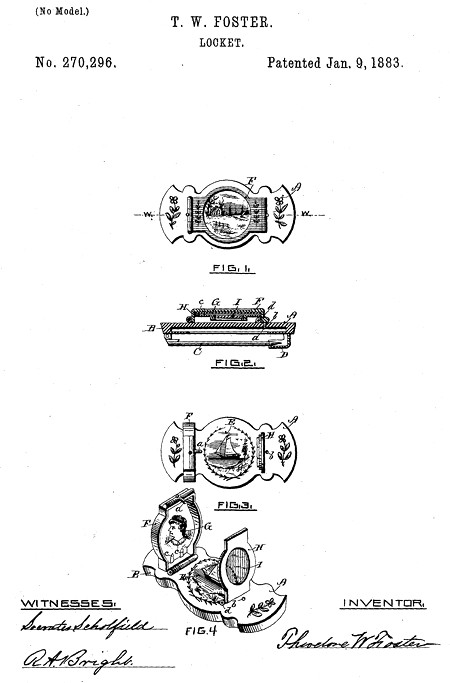
- He was issued patent number 370,396 on 9 Jan 1883
THEODORE W. FOSTER, OF PROVIDENCE, RHODE ISLAND.
LOCKET.
SPECIFICATION forming part of Letters Patent No. 370,396, dated January 9, 1883. Application filed November 4, 1882.
To all whom it may concern:
Be it known that I, Theodore W. Foster, of Providence, in the State of Rhode Island, have invented an Improvement in Lockets, of which the following is a specification.
The nature of my invention consists in the improved combination of a picture-box with a magnifying-lens and an ornamented plate, as hereinafter fully set forth.
Figure 1 is a plan view of my improvement as applied to a locket-pin. Fig. 2 is a longitudinal section taken in the line W W of Fig. 1. Fig. 3 is a plan view, showing the locket opened. Fig. 4 is a perspective view.
In the drawings, A is the front plate of a pin; B, the rim. G is the pivoted pin-tongue, and D the hook for holding the point of the tongue 0. The central portion of the plate A is provided with an engraved, stamped, or otherwise constructed ornamental design, E, and to the plate A, at one side of the design E, is hinged the box F, made smaller than the plate A and adapted to receive the picture G, which may be removably held by means of the spring-fingers c c. The pin a, attached to the outer end of the picture-box F, enters the hole b in the plate A when the box F is closed down upon the plate A.
At the side of the design E, opposite to the picture-box F, is hinged the perforated frame H, provided with the magnifying lens I, and the frame H and lens I may be automatically elevated by means of a spring at the hinge d upon raising the picture-box F from the plate A to its elevated position shown in Figs. 3 and 4. In closing the locket the frame H, carrying the lens I, is first folded down over the design E, and the box F then brought down so as to completely inclose the lens-frame H and design E, the pin a, attached to the rim of the box Centering the hole b with sufficient spring-friction to hold the whole in its folded condition, as shown in Figs. 1 and 2.
When the locket is opened the previously-covered ornamental design preserves the finish of the locket, so that whether in an open or closed condition it will present a highly ornamental appearance.
The drawings represent a locket adapted to be worn as a pin; but a ring may be secured to the same for attachment-to a chain, as in ordinary lockets.
I claim as my invention—
1. In a locket, the combination of the picture-box, hinged to a plate extending on opposite sides beyond the edge of the picture-box, with a lens-frame hinged to the same side of the plate and inclosed by the rim of the picture-box in the closed condition of the locket, substantially as described.
2. In a locket, the combination of the ornamented plate with the picture-box made smaller than the ornamented plate, and hinged to the said plate at one side, of a central ornamental design, with the lens-frame hinged to the same side (if the plate, at the opposite side of the ornamental design, and inclosed by the rim of the picture-box in the closed condition of the locket, substantially as described.
Theodore W. Foster
Witnesses:
Harmon S. Babcook
Socrates Scholfield
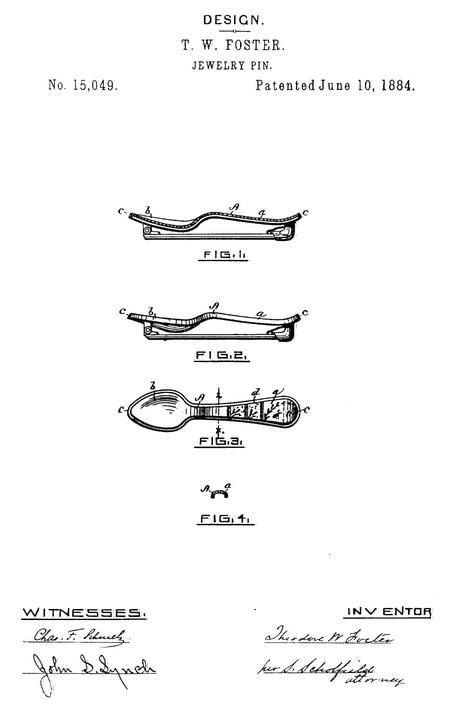
- Patent: 15,049, on 10 Jun 1884. THEODORE W. FOSTER, OF PROVIDENCE, RHODE ISLAND
DESIGN FOR A JEWELRY-PIN.
SPECIFICATION forming part of Design No, 15,049, dated June 10, 1884. Application filed March 17, 1884.
To all whom it may concern:
Be it known that I, Theodore W. Foster., of Providence, in the State, of Rhode Island, have invented and produced a new and original Design for the Plate of a Jewelry-Pin, of which the following is a specification:, reference being had to the accompanying drawings, forming a part thereof.
Figure 1 is a sectional view of my newly-designed front plate of a jewelry-pin. Fig. 2 is a side elevation of the same; Fig. 3, a face view, and Fig. 4 a transverse section taken in the line x x of Fig. 3, these four views being deemed necessary to fully illustrate my design.
The leading features of my design: consist in a plate the outline and front surface of which is made to represent a spoon, with the continuous outline edge of the plate turned backward for a nearly uniform distance from its front, and also having an engraved, chased, or embossed handle.
In the accompanying drawings, A is the plate, having the form of a spoon, the handle a and bowl b of which are provided with a uniform backwardly-turned edge, c, and the handle a is also provided with the engraved, chased, or embossed ornamentation d; but the form and style of the ornamentation d may be varied without affecting the general appearance of the whole design.
I claim as my invention—
The design for a jewelry-pin herein shown and described, the same consisting of a plate having the shape of a spoon, with the outline edge of the plate turned backward at a nearly uniform distance from its front, and the surface of the handle of the spoon showing an embossed or engraved ornamentation.
Theodore W. Foster
Witnesses:
Leander R. Briggs
Socrates Scholfield
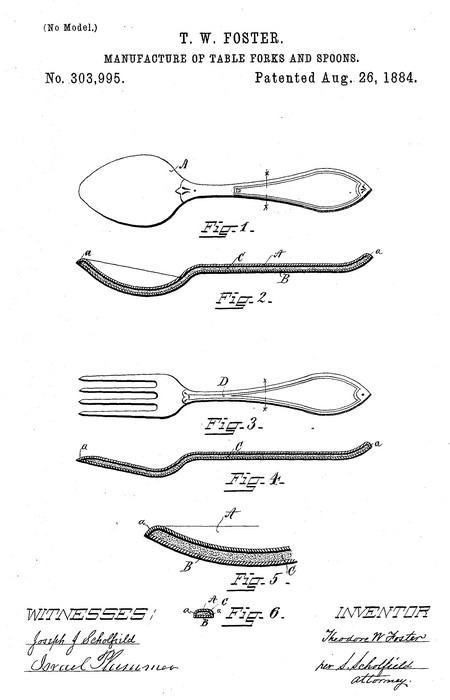
- He was issued patent number 303,995 on 26 Aug 1884
THEODORE W. FOSTER, OF PROVIDENCE, RHODE ISLAND.
MANUFACTURE OF TABLE FORKS AND SPOONS.
SPECIFICATION forming part of Letters Patent No. 303,995, dated August 26, 1884. Application filed March 10, 1884.
To all whom it may concern:
Be it known that I, Theodore W. Foster, of Providence, in the State of Rhode Island, have invented an Improved Manufacture of Gold-Plated Table Forks and Spoons, of which the following is a specification.
My invention relates to a new manufacture of gold-plated table forks and spoons, which consists in the combination of front and back plates made in hollowed form of rolled-gold-plated stock with an intervening filling of either hard or soft solder.
Figure 1 represents a face view of the spoon. Fig. 2 is a central longitudinal section of the same. Fig. 3 represents a face view of the fork. Fig. 4 is a longitudinal section of the same. Fig. 5 represents an enlarged section of a portion of the bowl of the spoon, Fig. 1. Fig. 6 represents a section taken in the line x x of Figs. 1 and 3.
In the accompanying drawings, Arepresents the front plate of a spoon, which is made in hollowed form by striking the edges a downward, as shown in Figs. 5 and 6. The back plate, B, is made in a less-hollowed form, as shown in Fig. 6, and cut out to fit within the turned edges of the front plate. The two plates are then flushed with either hard or soft solder C, and secured to each other by properly heating the soldered plates, after which the outline edge of the upper plate is to be burnished, thus properly extending the
gold-coating of the front plate in order to cover the base-metal edge of the same. The handle of the spoon may be embossed or otherwise ornamented, as desired. The table-fork, Figs. 3 and 4, is made in a similar manner by joining the front and back plates of rolled-gold-plated stock by means of the hard or soft solder filling 0, and the handle D may be strengthened by means of a piece of wire or of rolled metal embedded in the filling C of solder.
The object of my invention is to provide a manufacture of gold-plated table forks and spoons, in which the desirable appearance of a gold fork or spoon may be secured at a comparatively low cost, and I have discovered in practice that forks and spoons so manufactured are of sufficient strength and durability to meet the requirements of ordinary use and wear owing to the roll-hardened-gold surface, the wearing qualities of which are greatly superior to that of an electro-gilded surface.
I claim as my invention—
As a new article of manufacture, a gold-plated table fork or spoon consisting of a front plate of rolled-gold-plated stock and a back plate of the same material joined to the front plate by means of an intervening filling of solder.
Theodore W. Foster
Witnesses:
Leander R. Briggs
Socrates Scholfield
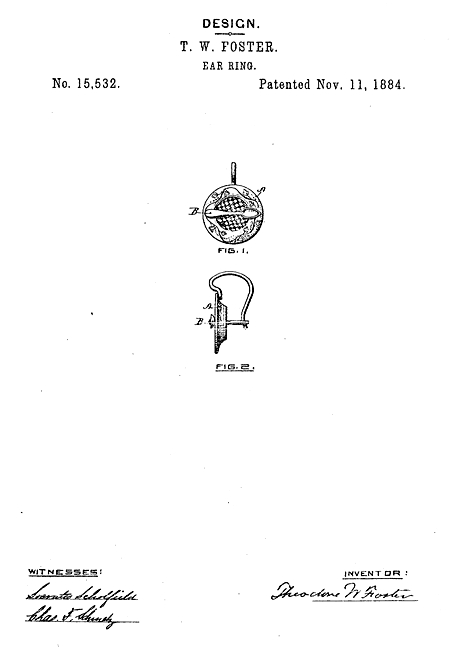
- Patent: 15,532, on 11 Nov 1884. THEODORE W. FOSTER, OF PROVIDENCE, RHODE ISLAND.
DESIGN FOR AN EAR-RING.
SPECIFICATION forming part of Design No. 15,532, dated November 11, 1884. Application filed July 31, 1884. Term of patent 7 years.
To all whom it may concern:
Be it known that I, Theodore W. Foster, a citizen of the United States, residing at Providence, in the State of Rhode Island, have invented and produced a new and original Design for an Ear-Ring, of which the following is a specification, reference being had to the accompanying drawings, forming a part thereof.
Figure 1 is a front view of my newly-designed ear-ring. Fig. 2 is an edge elevation of the same.
The leading feature of my design consists in a represented eating-plate crossed by an eating implement, which may be either a spoon, fork, or table-knife.
In the accompanying drawings, A represents the plate in proper hollowed form, and crossed by an eating implement, B. I claim—
The design for an ear-ring herein shown and described, the same consisting of the represented eating-plate and eating implement.
THEODORE W. FOSTER
Witnesses:
Socrates Scholfield
Chas. F. Schmelz
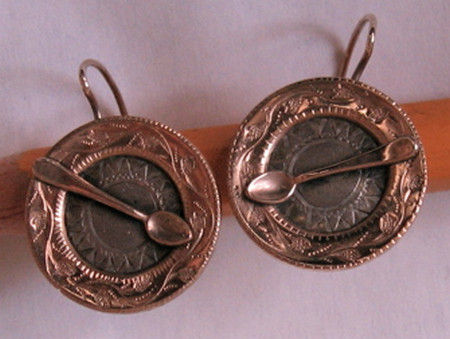
- Example: Earrings, in Private Collection.
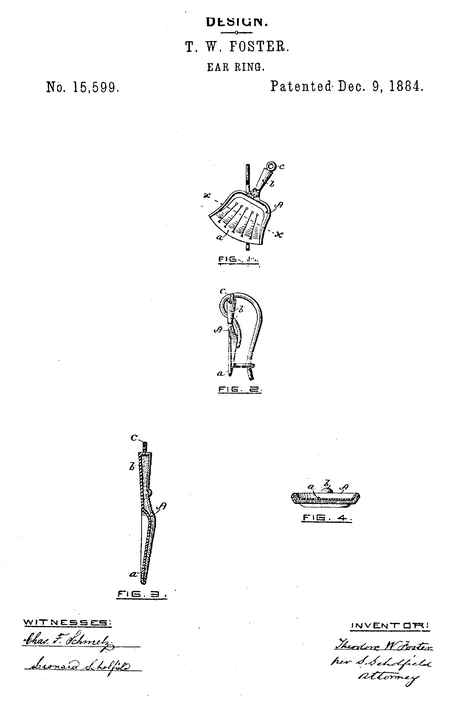
- Patent: 15,599, on 9 Dec 1884. THEODORE W. FOSTER, OF PROVIDENCE, RHODE ISLAND.
DESIGN FOR AN EAR-RING.
SPECIFICATION forming part of Design No. 15,599, dated December 9, 1884. Application filed September 19, 1884. Term of patent 7 years.
To all whom it may concern:
Be it known that I, Theodore W. Foster, of Providence, in the State of Rhode Island, have invented and produced a new and original Design for Ear-Rings, of which the following is a specification, reference being had to the accompanying drawings, forming a part thereof.
Figure 1 is a front view of my newly-designed pendent jewelry ornament employed as an ear-ring. Fig. 2 is a side elevation of the same. Fig. 3 is a central longitudinal section of the ornament. Fig. 4 is a transverse section of the same, taken in the line x x of Fig. 1.
The leading feature of my design consists in a pendent jewelry ornament the outline and front surface of which represents a dust-pan and its handle, the surface of the pan being provided with ornamentation.
In the accompanying drawings, A is the ornamental plate of an ear-ring in the form of a dust-pan, consisting of the pan a and the handle b, provided with the ring e, the face of the pan a being provided with ornamentation.
I claim—
The design for an ear-ring herein shown and described, the same consisting of a plate the outline and front surface of which represents a dust-pan and its handle, the face of the pan being provided with ornamentation.
Theodore W. Foster
Witnesses:
Socrates Scholfield
Chas. F. Schmelz
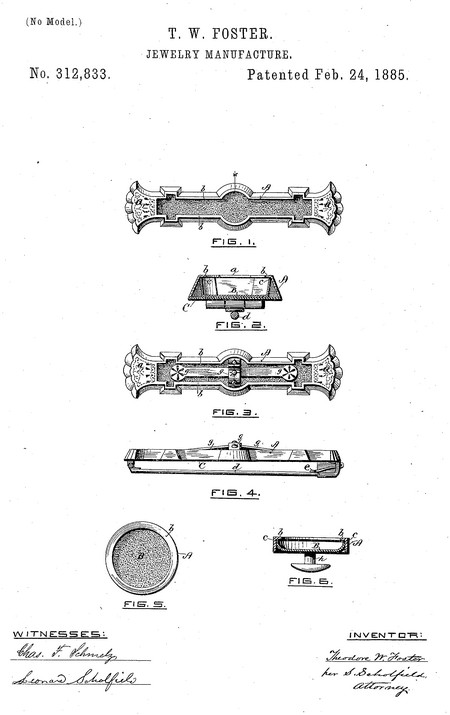
- He was issued patent number 312,833 on 24 Feb 1885
THEODORE W. FOSTER, OF PROVIDENCE, RHODE ISLAND.
JEWELRY MANUFACTURE.
SPECIFICATION forming part of Letters Patent No. 312,833, dated February 24, 1885. Application filed October 7, 1884.
To all whom it may concern:
Be it known that I, Theodore W. Foster of Providence, in the State of Rhode Island, have invented an Improvement in the Manufacture of Jewelry, of which the following is a specification.
The nature of my invention consists in the improved construction of the ornamental box of a piece of jewelry, as hereinafter set forth, and my invention is adapted for the improved manufacture of the box ornaments of pins, earrings, bracelets, buttons, &c.
Figure 1 is a face view of a jewelry-pin embodying my improvement. Fig. 2 is a transverse section of the same, taken in the line x of Fig. 1. Fig. 3 is a face view of the pin shown in Fig. 1, provided with supplemental ornamentation. Fig. 4 is an edge view of the same. Fig. 5 is a-face view, and Fig. 6 a vertical section, of a sleeve button, also embodying my improvement.
In the accompanying drawings, Figs. 1 and 2, A is the rim of a jewelry-pin "struck up" in one piece, and provided on its face side, a, with an inwardly-projecting flange, b. B is the lining-plate, which may be either made of the same material with the rim A, or, preferably, of a contrasting material, or it may be provided with a contrasting ornamentation on its front surface, a lining-plate, B, having a. matted or pebbled front surface being shown in the drawings. The plate B is provided with an upwardly-turned edge, c,which is arranged to rest in close proximity to the under side of the inwardly-projecting flange b, as shown in Fig. 2, and at the rear of the rim A and plate B is secured the back plate, C, to which the pin-tongue d and catch e are attached in the usual manner. The combination of the inwardly-flanged rim and the contrasting back plate provided with upwardly-turned edges, causes the box-ornament of a pin or other article of jewelry to present a light elegant appearance.
In order to further enhance the ornamental effect of the article of jewelry having a rim, A, and lining-plate B constructed as above described, I attach one or more ornamental pieces, g, which maybe made in any desirable form, either in advance or upon the lining-plate, as shown in Figs. 3 and 4.
In the manufacture of sleeve-buttons, as shown in Figs. 5 and 6, the back plate, G, may be dispensed with, the post h being attached directly to the back of the cup-formed lining-plate B, which is made to fit within the flanged rim A, with the upwardly-turned edge c resting against the under side of the inwardly-projecting flange b.
I claim as my invention —
1. In an article of jewelry, the combination of the rim of the front face, having an inwardly-projecting flange on its front edge, and the ornamental lining-plate having an upwardly-turned edge which extends to close proximity to the under side of the flange of the rim, and a fastening attachment beneath the lining-plate, substantially as described. ,
2. The combination of the rim having an inwardly-projecting flange on its front edge, the lining-plate having an upwardly-turned edge which extends to close proximity to the under side of the flange of the rim, the back plate, and the ornamental piece or pieces arranged in front of the lining-plate, substantially as described.
Theodore W. Foster
Witnesses:
Socrates Scholfield
Chas. F. Schmelz

- Example: Envelope, in 1888, in Private Collection.

- Advertised: The Jewelers Circular, on 5 Feb 1896.
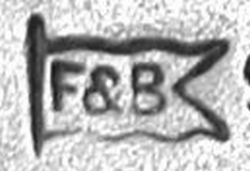
- Partnership: Isaac F. Foster, after 1890, in Providence RI. As FOSTER & BROTHER.

- Patent: 28,727, on 31 May 1898. THEODORE W. FOSTER, OF PROVIDENCE, RHODE ISLAND.
DESIGN FOR A BOX.
SPECIFICATION forming part of Design No. 28,727, dated May 31, 1898. Application filed March 31, 1898. Serial No. 676,001. Term of patent 3 1/2 years.
To all whom it may concern:
Be it known that I, Theodore W. Foster, of Providence, in the county of Providence and State of Rhode Island, have invented and produced a new and original Design for Boxes for Manicure or Similar Articles, of which the following is a specification, reference being had to the accompanying drawings, forming part thereof.
Figure 1 is a perspective view of an open box, showing my design. Fig. 2 is a top view of the same. Fig. 3 is a side view of the box.
The leading and material feature of my design consists in the peculiar and novel outline of the box, in which three sections of circles intersect each other at three points to form the outline of the box.
In the drawings, 3 indicates the bottom portion, and 4 the top portion, of the box; 5, the slightly - raised top, having rounded edges along the margin of the same. In plane view the box is formed of three sections of circles joined at the three points 6 6 6, each circular section being greater than a half-circle, the whole presenting the outline of the conventional three-leaved clover. The sides of the two parts of the box are vertical and follow the outline and are connected together on two of the sections of circles, the ornamental latch 7 being on the farthest projection of the third circular section, so that when open the box presents to the eye the conventional appearance of two three-branched clover-leaves,each having a raised marginal edge.
Having thus described my invention, what I claim as new, and desire to secure by Letters Patent, is—
The design for a box for manicure or similar articles herein shown and described.
In witness whereof I have hereunto set my hand.
Theodore W. Foster
Witnesses:
Joseph A. Miller, Jr.
B. M. Simms
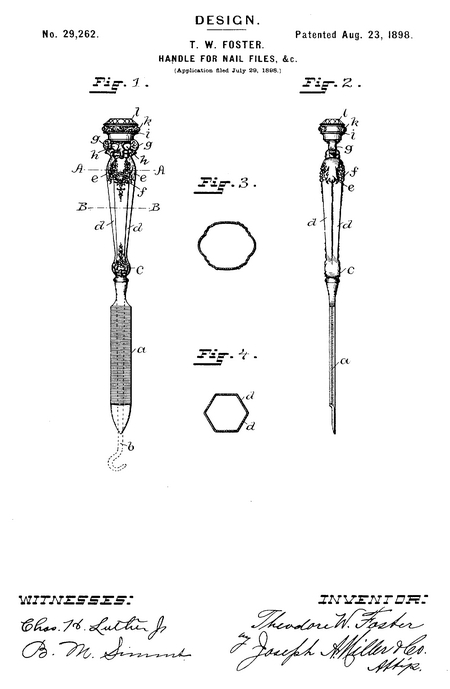
- Patent: 29,262, on 23 Aug 1898. THEODORE W. FOSTER, OF PROVIDENCE, RHODE ISLAND.
DESIGN FOR A HANDLE FOR NAIL-FILES, &c
SPECIFICATION forming part of Design No. 29,262, dated August 23, 1898. Application filed July 29, 1898. Serial No. 687,219. Term of patent 3 1/2 years.
To all whom it may concern:
Be it known that I, Theodore W. Foster, of Providence, in the county of Providence and State of Rhode Island, have invented and produced a new and original Design for the Handles of Nail-Files and Similar Articles, of which the following is a specification, reference being had to the accompanying drawings, forming part thereof.
Figure 1 is a front view of the handle, showing my design. Fig. 2 is a side view of the same. Fig. 3 is a sectional view on the line AA of Fig. 1; and Fig. 4, a sectional view on the line BB.
The leading feature of my design consists in the six-sided tapering form of the handle surmounted with the ornamented head terminating in the faceted disk, as will be more fully set forth hereinafter.
In the drawings, a indicates a nail-file, to which the handle is secured. A button-hook b is indicated in broken lines. The lower part of the handle is formed into the bulb c, the two opposite sides of which are ornamented with a floral design. From the bulb c the handle gradually enlarges, forming six tapering sides dd, terminating near the upper end in the inwardly-curved leaf ornaments ee, the space between which is ornamented on each side by the pendent floral ornaments ff. The two oppositely-disposed foliated scrolls gg support the seal-shaped knob i, the upper member of which is ornamented by the foliated scrolls K and is surmounted by the faceted disk or jewel l. The handle presents to the eye the appearance of a tapering six-sided ornamental jeweled hilt or handle.
Having thus described my invention, what I claim as new, and desire to secure by Letters Patent, is—
The design for the handle of a nail-file or similar article substantially as herein shown and described.
In witness whereof I have hereunto set my hand.
Theodore W. Foster
Witnesses:
B. M. Simms
J. A. Miller, Jr.

- Example: Vanity set, in Private Collection.
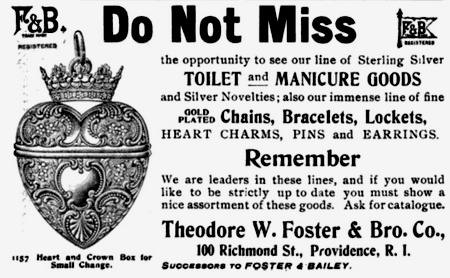
- Advertised: The Jewelers Circular, on 19 Oct 1898.
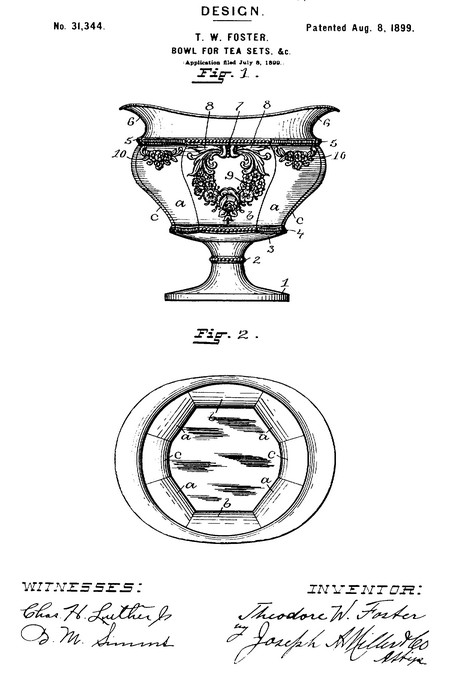
- Patent: 31,344, on 8 Aug 1899. THEODORE W. FOSTER, OF PROVIDENCE, RHODE ISLAND.
DESIGN FOR A BOWL FOR TEA-SETS, &.c.
SPECIFICATION forming part of Design No. 31,344, dated August 8, 1899. Application filed July 8, 1899. Serial No, 723,251. Term of patent 7 years.
To all whom it may concern.
Be it known that I, Theodore W. Foster, of Providence, in the county of Providence and State of Rhode Island, have invented and produced a new and original Design for the Bowl of Tea-Sets or Similar Articles, of which the following is a specification, reference being had to the accompanying drawings, forming part thereof.
Figure 1 is a side view of a sugar-bowl, showing my design. Fig. 2 is a top view of the same.
Tea-sets usually consist of a number of pots, bowls, and cups, some with and some without handles and some provided with a spout. In such sets the bowls of the several articles in a set are usually of the same shape and have the same ornamentation.
The leading feature of my design consists in the eight sides, two of which—one on each side of the bowl—are broader than the rest, all having curved ogee surfaces, a wreath ornamentation on the broader, and festoons on the smaller of the sides or facets of the bowl, presenti ng to the eye an elongated eight-sided ogee bowl with a more distinctly ornamented central surface.
In the drawings, the base 1 slopes inward from the peripheral rim and curves upward to form the contracted stem, surrounded by the pearl-beaded ring 2, from which the stern curves outward to join the convex bottom 3 of the bowl. The margin of the bottom 3 is eight-sided, as shown in Fig. 2. The four sides a a are of equal width. The sides or facets b b are of greater width than the sides a a, and the sides c c are of less width than the sides a a. This proportion is maintained in the bowl, in which the eight sides extend from the bottom 3 on outwardly-expanding ogee curves. The edge of the bottom of the bowl is ornamented by the pearl-beaded border 4. Around the upper end of the bowl the pearl-beaded border 5 divides the bowl proper from the curved rim 6, having extended ewer-shaped margins at the opposite ends. On the sides bb is a raised ornamentation consisting of the beaded central band 7, from which the foliated scrolls 8 8 extend in opposite directions to the pendent floral garland 9, covering the greater portion of the side or facet of the bowl. The pendent floral garlands 10 ornament the upper part of the sides or facets a a of the bowl.
When handles or a spout are used on the bowls, these are secured on the sides or facets c c of the bowl.
Having thus described my invention, what I claim as new, and desire to secure by Letters Patent, is—
The design for the bowl of tea-sets or similar articles herein shown and described.
In witness whereof I have hereunto set my hand.
Theodore W. Foster
Witnesses:
J. A. Miller, Jr.
B. M. Simms
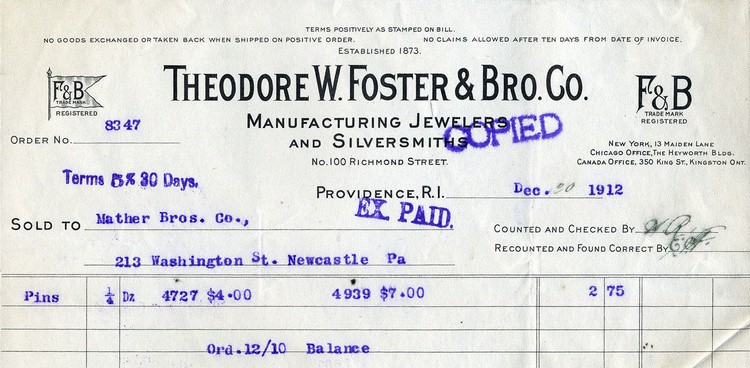
- Example: Billhead for FOSTER & BROTHER, in 1912, in Private Collection.
|































